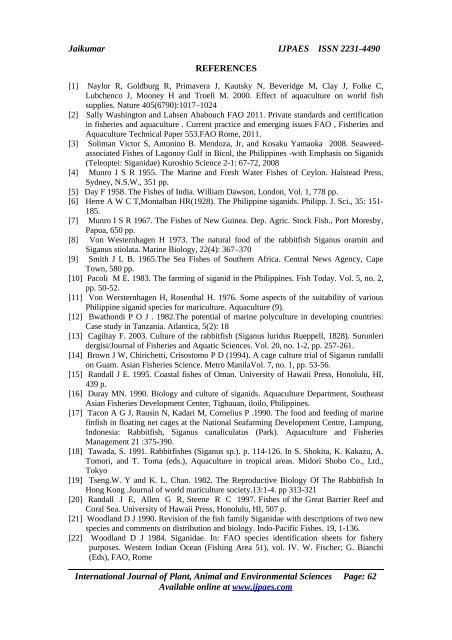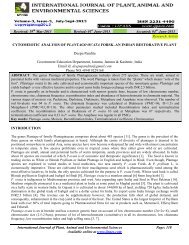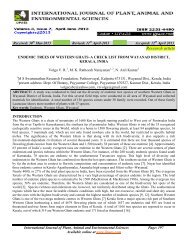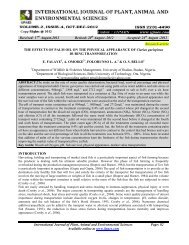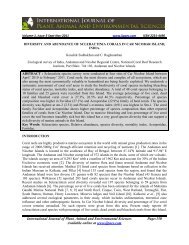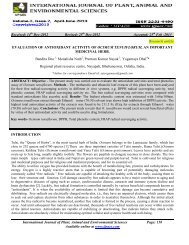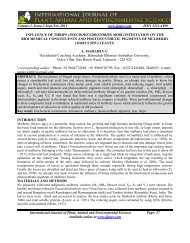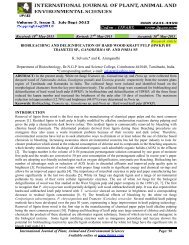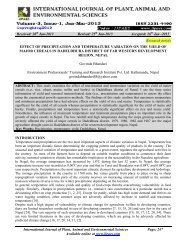siganus canaliculatus - Ijpaes.com
siganus canaliculatus - Ijpaes.com
siganus canaliculatus - Ijpaes.com
You also want an ePaper? Increase the reach of your titles
YUMPU automatically turns print PDFs into web optimized ePapers that Google loves.
Jaikumar IJPAES ISSN 2231-4490REFERENCES[1] Naylor R, Goldburg R, Primavera J, Kautsky N, Beveridge M, Clay J, Folke C,Lubchenco J, Mooney H and Troell M. 2000. Effect of aquaculture on world fishsupplies. Nature 405(6790):1017–1024[2] Sally Washington and Lahsen Ababouch FAO 2011. Private standards and certificationin fisheries and aquaculture . Current practice and emerging issues FAO , Fisheries andAquaculture Technical Paper 553.FAO Rome, 2011.[3] Soliman Victor S, Antonino B. Mendoza, Jr, and Kosaku Yamaoka 2008. SeaweedassociatedFishes of Lagonoy Gulf in Bicol, the Philippines -with Emphasis on Siganids(Teleoptei: Siganidae) Kuroshio Science 2-1: 67-72, 2008[4] Munro I S R 1955. The Marine and Fresh Water Fishes of Ceylon. Halstead Press,Sydney, N.S.W., 351 pp.[5] Day F 1958. The Fishes of India. William Dawson, London, Vol. 1, 778 pp.[6] Herre A W C T,Montalban HR(1928). The Philippine siganids. Philipp. J. Sci., 35: 151-185.[7] Munro I S R 1967. The Fishes of New Guinea. Dep. Agric. Stock Fish., Port Moresby,Papua, 650 pp.[8] Von Westernhagen H 1973. The natural food of the rabbitfish Siganus oramin andSiganus stiolata. Marine Biology, 22(4): 367–370[9] Smith J L B. 1965.The Sea Fishes of Southern Africa. Central News Agency, CapeTown, 580 pp.[10] Pacoli M E. 1983. The farming of siganid in the Philippines. Fish Today. Vol. 5, no. 2,pp. 50-52.[11] Von Wersternhagen H, Rosenthal H. 1976. Some aspects of the suitability of variousPhilippine siganid species for mariculture. Aquaculture (9).[12] Bwathondi P O J . 1982.The potential of marine polyculture in developing countries:Case study in Tanzania. Atlantica, 5(2): 18[13] Cagiltay F. 2003. Culture of the rabbitfish (Siganus luridus Rueppell, 1828). Surunleridergisi/Journal of Fisheries and Aquatic Sciences. Vol. 20, no. 1-2, pp. 257-261.[14] Brown J W, Chirichetti, Crisostomo P D (1994). A cage culture trial of Siganus randallion Guam. Asian Fisheries Science. Metro ManilaVol. 7, no. 1, pp. 53-56.[15] Randall J E. 1995. Coastal fishes of Oman. University of Hawaii Press, Honolulu, HI,439 p.[16] Duray MN. 1990. Biology and culture of siganids. Aquaculture Department, SoutheastAsian Fisheries Development Center, Tigbauan, iloilo, Philippines.[17] Tacon A G J, Rausin N, Kadari M, Cornelius P .1990. The food and feeding of marinefinfish in floating net cages at the National Seafarming Development Centre, Lampung,Indonesia: Rabbitfish, Siganus <strong>canaliculatus</strong> (Park). Aquaculture and FisheriesManagement 21 :375-390.[18] Tawada, S. 1991. Rabbitfishes (Siganus sp.). p. 114-126. In S. Shokita, K. Kakazu, A.Tomori, and T. Toma (eds.), Aquaculture in tropical areas. Midori Shobo Co., Ltd.,Tokyo[19] Tseng.W. Y and K. L. Chan. 1982. The Reproductive Biology Of The Rabbitfish InHong Kong .Journal of world mariculture society.13:1-4. pp 313-321[20] Randall J E, Allen G R, Steene R C 1997. Fishes of the Great Barrier Reef andCoral Sea. University of Hawaii Press, Honolulu, HI, 507 p.[21] Woodland D J 1990. Revision of the fish family Siganidae with descriptions of two newspecies and <strong>com</strong>ments on distribution and biology. Indo-Pacific Fishes. 19, 1-136.[22] Woodland D J 1984. Siganidae. In: FAO species identification sheets for fisherypurposes. Western Indian Ocean (Fishing Area 51), vol. IV. W. Fischer; G. Bianchi(Eds), FAO, RomeInternational Journal of Plant, Animal and Environmental Sciences Page: 62Available online at www.ijpaes.<strong>com</strong>


